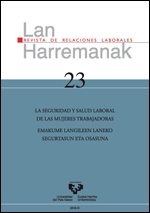El acoso laboral desde la perspectiva de la prevención de riesgos laborales. Breves apuntes
##plugins.themes.bootstrap3.article.main##
##plugins.themes.bootstrap3.article.sidebar##
Abstract
The article «Harassment in the workplace from the standpoint of the prevention of risks at work» attempts to reflect on the different types of harassment that can take place in the workplace and also the possible means for protecting against them.
It aims at establishing what can be identified as such within the indeterminacy per se of what characterizes harassment —drawing a distinction for such purpose between moral, gender and sexual harassment.
Once light has been shed on the above, the position of the worker as a victim of such conduct is then determined so as to show in general terms that preventive channels can exist that may prevent harassment in the workplace. Designing certain possible tools for such purpose is what the article attempts to do, in addition to trying to highlight the difficult position in which the victim of this type of conduct finds themselves on many occasions —such conduct always being difficult to prove.
How to Cite
##plugins.themes.bootstrap3.article.details##
Authors who publish in the journal "Lan Harremanak" do so in agreement with the following terms:
1. Authors retain the copyright of their papers. while ceding to the journal "Lan Harremanak" the right to the first publication of their article.
2. The publisher UPV/EHU Press is a joint copyright holder, in order to protect the legitimate use of the published paper and compliance with CC terms.
3. Published papers are subject to a Creative Commons CC-BY license (unless stated otherwise) which permits third parties to share the paper, on the condition that the author and source are specified when material is reproduced.
4. Authors can enter into other non-exclusive license agreements regarding the published version of their work (e.g. depositing it in an institutional repository or re-publishing it as a monographic volume), providing the author and source are given appropriate credit.
5. Dissemination of submitted articles via Internet is both allowed and recommended (e.g. in institutional repositories and/or on the researcher's web page), both before and during the process of submission, since this can lead to interesting dialogues and also increase citations to the eventual publication.

